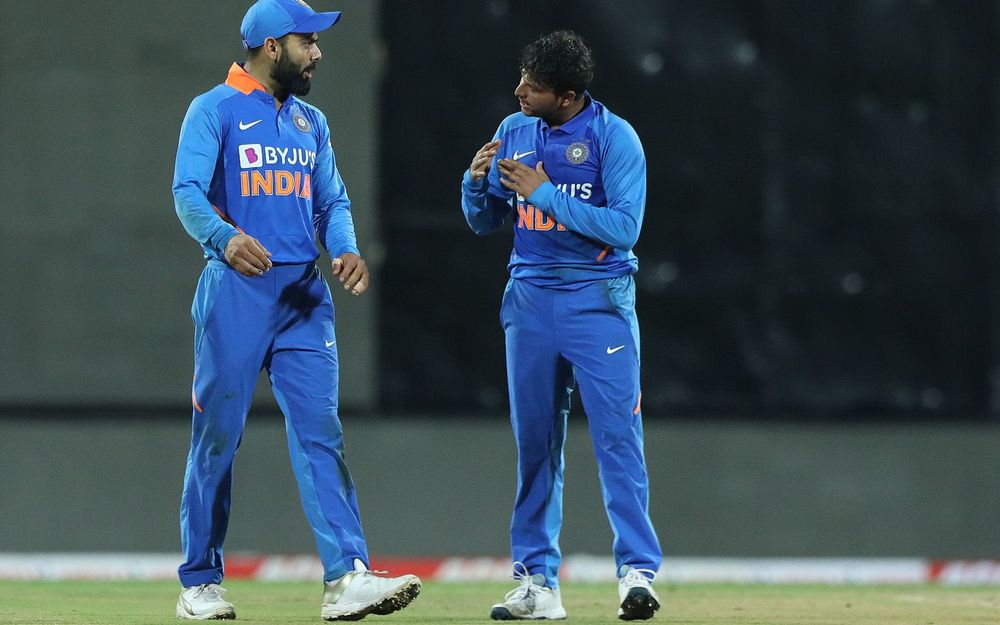Who removed my fifth bowler
In Indian populace, conservatism has been best served as a main course, with aggressive intent and gung-ho attitude complementing it as the choice for the worst-case scenario. This could be tackling a seminal life situation, or could well be the Indian limited-overs cricket team too.

"What makes the Indian team unique is that it's consistently playing risk-free cricket," Sanjay Bangar told Mumbai Mirror before departing for the World Cup. "And that's because we emphasise on ones and twos. As a batting group, we are not obsessed with the number of boundaries we've hit. But we discuss strike-rotation a great deal. Which is why we're able to eschew risks."
While India’s batting plans, which follow a chorus of sorts to give its “fulfilling avatar” a shiny disposition, even with the benefit of hindsight, many might not agree that it faltered flat on their face. Be it their failure to recognise their No.4 batsman to shuttling KL Rahul from opening to middle-order for eternity, it was the fickleness that had been the biggest contributor to every Indian failure - be it losing three in a row to Australia at home in March or the latest Windies loss.
Bhuvneshwar Kumar suffered a last-minute injury, only to be replaced by a toothless Shardul Thakur. Jasprit Bumrah’s stress fracture has kept him out for the last three months, and if the rehab is anything to go by, he would be out for the upcoming Sri Lanka and Australia series too. However, on a Chennai track, with wickets being under cover for more than two days, India went ahead with two spinners and two pacers, alongside two more part-timers. Both Shivam Dube and Kedar Jadhav are no more than holding bowlers and can be considered as nothing but sixth bowlers. Call it overconfidence or thinking to extend the batting order, India seriously messed it up. And it doesn’t require hindsight to grasp the idea.
In the Windies series just after the World Cup, Bumrah was rested, but India went ahead with the trio of Bhuvneshwar, Mohammed Shami and Khaleel Ahmed. It helped that Kuldeep Yadav and Ravindra Jadeja were an integral part of the team, and with five bowlers, India trusted Kedar Jadhav to do the job if required. With Bhuvneshwar injuring himself once again, the team had an option to make in Chennai - it could have been a 3-2 or 2-3 combination - but surprisingly Dube’s Nagpur heroics instil such hope that Kohli had gone with an over-aggressive approach.
In cricket, more than any other sport, form matters and if the player is not in the zone, trusting them to get the job done is the worst thing you can do. Kuldeep is understandably shaken after that horror KKR-RCB game in last year’s IPL and is yet to recover from the jolt that he had received at the hands of Moeen Ali, but what has India done to give him his confidence back? He has been dropped, called back, dropped again, and called back again to carry the mantle ALONE. Nevermind, he failed massively.
It is exactly where the problem lies. The knock-on effect of doubling down on this tactic was the situation in the Windies ODI when India had three players pencilled into bowling in first powerplay and middle-overs, with Shami being the only bowler to strike in both middle and death. Everyone was going for runs in the middle and in the absence of Plan B, they resorted to bowling defensively. It was to the credit of Shai Hope and Shimron Hetmyer that they adopted two different approaches to figure out the run-chase - one staying back comfortably and the other taking on the attack.

 © BCCI
© BCCIUnfortunately for India, the worst-case scenario came true in a game that they would have thought a cakewalk. It, however, opens up a box of possibilities that might wake up Indian team management from their slumber, or at least, I hope so. Both Vizag and Cuttack - the hosts for the second and third ODI respectively - are absolute beds, with no kind of bowlers finding the escape route. The last time Vizag hosted an ODI, it was Shai Hope and Virat Kohli who scored two stunning centuries in a tied game and well, who could forget the Yuvraj-Dhoni assault in that Cuttack ODI. Could India afford to drop the ball there once again? Go figure out.
To be fair with Indian team management, their current set-up is a product of circumstances, most of them self-made, though. They possess attacking players who have shown themselves to be uninhibited by the bright lights of international cricket and have stood tall to deliver. But things have changed massively when players have been constantly chopped and changed, making the process look like a disaster in the first place.
With the troika of Chahar, Shami, Kuldeep being absolute noughts with the bat, dropping Jadeja is beyond the realms of considerations. Bringing in Chahal will mean India will have more assurance to crack the middle-over bowling code and won’t have to resort to pressing the panic button until Bumrah is back with all his glory and Bhuvneshwar is back to his familiar territory of having someone with relentless pressure from the other end. Understanding and breaking things down might help the cause as India aspire for something big next year in Australia. But till then, the onus is on India to correct the wrongs and lay down the marker. Can Vizag be the beginning of it?

Comments
Sign up or log in to your account to leave comments and reactions
0 Comments